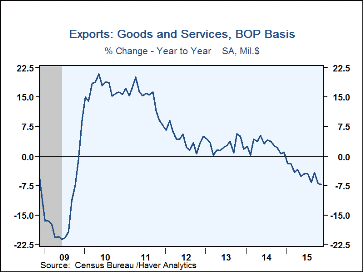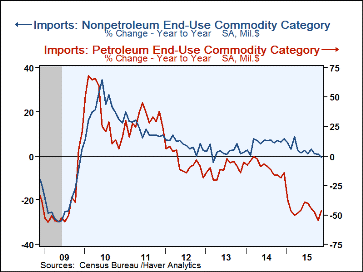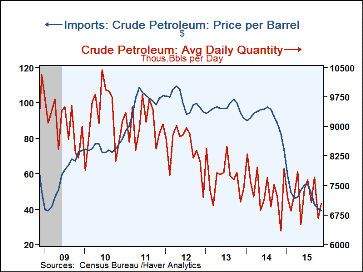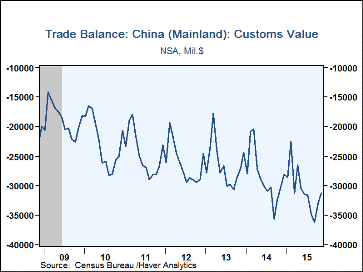 Global| Jan 06 2016
Global| Jan 06 2016November U.S. Trade Deficit Narrows Mostly on Weaker Imports
by:Sandy Batten
|in:Economy in Brief
Summary
The U.S. foreign trade deficit narrowed to $42.4 billion in November from a revised $44.6 billion in October (initially -$43.9 billion). The Action Economics Forecast Survey had anticipated a deficit of $44.2 billion. However, the [...]
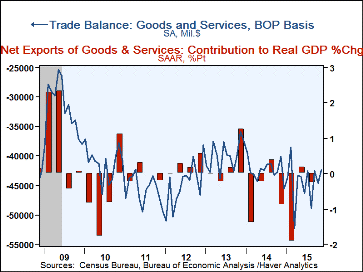 The U.S. foreign trade deficit narrowed to $42.4 billion in November from a revised $44.6 billion in October (initially -$43.9 billion). The Action Economics Forecast Survey had anticipated a deficit of $44.2 billion. However, the advance report on the goods trade deficit, released on December 29, had pointed to a narrowing in line with that observed in today's release. In November, the goods deficit narrowed $2.3 billion to $61.3 billion while the services surplus narrowed marginally by $0.1 billion to $18.9 billion. Both exports and imports fell in November. Exports slipped 0.9% m/m (-7.1% y/y) with industrial supplies and consumer goods showing the most weakness. This was the fifth month in the past seven in which exports have declined, reflecting the impact of weak growth abroad as well as the stronger US dollar. Imports fell almost twice as much as exports, down 1.7% m/m for a 4.9% y/y decline. Consumer goods and capital goods led the November decline in imports.
The U.S. foreign trade deficit narrowed to $42.4 billion in November from a revised $44.6 billion in October (initially -$43.9 billion). The Action Economics Forecast Survey had anticipated a deficit of $44.2 billion. However, the advance report on the goods trade deficit, released on December 29, had pointed to a narrowing in line with that observed in today's release. In November, the goods deficit narrowed $2.3 billion to $61.3 billion while the services surplus narrowed marginally by $0.1 billion to $18.9 billion. Both exports and imports fell in November. Exports slipped 0.9% m/m (-7.1% y/y) with industrial supplies and consumer goods showing the most weakness. This was the fifth month in the past seven in which exports have declined, reflecting the impact of weak growth abroad as well as the stronger US dollar. Imports fell almost twice as much as exports, down 1.7% m/m for a 4.9% y/y decline. Consumer goods and capital goods led the November decline in imports.
The real trade deficit in goods (that is, measured in chained 2009 dollars) also narrowed in November to $59.6 billion from $61.0 billion in October. Given the data for October and November, the real goods trade deficit is set to widen in the fourth quarter from the third, indicating that the trade balance will be a further drag on overall GDP in the fourth quarter. At the present pace the trade balance is set to subtract about 0.5%-pt (at an annual rate) from 4Q GDP growth after having subtracted 0.3%-pt in 3Q.
Petroleum exports in current prices fell 3.5% m/m in November (-35.8% y/y). This was the fifth monthly decline in the past six months. Petroleum imports in current prices rebounded 5.1% m/m in November (-46.7% y/y), their first monthly increase in four months.
By country, the trade deficit in goods with China narrowed slightly to $31.3 billion from $33.0 billion. Exports were down 11.9% from a year earlier while imports slipped only 0.9% y/y. The deficit with Japan widened slightly to $5.7 billion in November from $5.6 billion with exports falling 2.1% y/y and imports edging up 0.2% y/y. The trade deficit with the European Union widened to $13.8 billion from $13.4 billion in October. Exports were essentially unchanged from a year ago while imports were up 5.4% y/y.
The international trade data can be found in Haver's USECON database. Detailed figures are available in the USINT database. The expectations figures are from the Action Economics Forecast Survey, which is carried in the AS1REPNA database
| Foreign Trade in Goods & Services (Current Dollars) | Nov | Oct | Sep | Y/Y | 2014 | 2013 | 2012 |
|---|---|---|---|---|---|---|---|
| U.S. Trade Deficit | $42.4 bil. | $44.6 bil. | $42.5 bil. | $40.0 bil. (11/14) |
$508.3 | $478.4 bil. | $536.8 bil. |
| Exports of Goods & Services (% Chg) | -0.9 | -1.6 | 1.4 | -0.8 | 2.8 | 2.8 | 4.3 |
| Imports of Goods & Services (% Chg) | -1.7 | -0.4 | -1.6 | -1.8 | 3.4 | 0.1 | 3.0 |
| Petroleum | 5.1 | -13.2 | -8.3 | -10.0 | -9.7 | -11.0 | -5.5 |
| Nonpetroleum | -2.4 | 0.6 | -1.7 | -0.9 | 6.1 | 2.0 | 5.2 |
Sandy Batten
AuthorMore in Author Profile »Sandy Batten has more than 30 years of experience analyzing industrial economies and financial markets and a wide range of experience across the financial services sector, government, and academia. Before joining Haver Analytics, Sandy was a Vice President and Senior Economist at Citibank; Senior Credit Market Analyst at CDC Investment Management, Managing Director at Bear Stearns, and Executive Director at JPMorgan. In 2008, Sandy was named the most accurate US forecaster by the National Association for Business Economics. He is a member of the New York Forecasters Club, NABE, and the American Economic Association. Prior to his time in the financial services sector, Sandy was a Research Officer at the Federal Reserve Bank of St. Louis, Senior Staff Economist on the President’s Council of Economic Advisors, Deputy Assistant Secretary for Economic Policy at the US Treasury, and Economist at the International Monetary Fund. Sandy has taught economics at St. Louis University, Denison University, and Muskingun College. He has published numerous peer-reviewed articles in a wide range of academic publications. He has a B.A. in economics from the University of Richmond and a M.A. and Ph.D. in economics from The Ohio State University.


